|
1.
CENTRAL/ WEST AFRICA
Prices holding firm till mid-year
There were no significant changes in prices for West/Central African timber products in early May.
Prices and markets are still very firm and expected to remain bullish till mid-year when summer vacations start
in Continental Europe and trade slows down for around six weeks. The effect in the UK is less notable as
vacations are normally taken in August and the slow down in trade is much less marked than in mainland Europe.
China increases investment in Africa's forest industry
In addition to the ongoing investment in minerals in Africa, China is increasing its investment in the
continent's forest industry, particularly in Gabon. Chinese firms are now investing heavily in
timber industries both logging and sawmilling and buying logs and lumber from established producers.
African sawnwood prices have room for further rise
Tight log supplies and low processing outputs in Southeast Asia are benefiting West African producers
and processors. Although these producers have not yet taken up all the slack in the regional price differences, it
is clear that West African sawn and processed lumber price levels have further to rise. India, China and, to a
lesser extent, South Africa remain very active in the region.
Cameroon secures foreign debt relief
The International Monetary Fund (IMF) and the World Bank's International Development Association (IDA)
agreed that Cameroon has made sufficient progress and taken the necessary steps to reach its completion point
under the Enhanced Heavily Indebted Poor Countries (HIPC) Initiative. Cameroon becomes the 19th country to
reach the completion point under HIPC. Debt relief to Cameroon under HIPC will be approximately $1.267
billion in 1999 net present value terms, equivalent to a 27% NPV reduction of Cameroon¡¯s debt after traditional
debt relief. This will reduce Cameroon¡¯s future debt service payments by about $4.9 billion in nominal terms.
In reaching the HIPC completion point, Cameroon also becomes eligible for further debt relief from the
IMF, IDA, and the African Development Fund (ADF) under the Multilateral Debt Relief Initiative (MDRI). Debt
relief provided under MDRI will amount to $1.13 billion at the current exchange rate.
Congo opens two new FMUs for tender
The Republic of Congo is inviting proposals for application for two forest management units (FMUs) in
the country located in the Sud 8 Sibit forest in Lekoumou department:
-- The Gouongo FMU (244,632 ha), allowable annual cut (AAC, based on main timber
species) 80,000 m3.
-- The Ingoumina-Lelali FMU (245,860 ha), AAC 72,470 m3.
The FMUs are for logging and timber processing according to the country's forest regulations. The
successful bidder should abide by the AAC; ensure that the processing plant is in harmony with the capacity of
the FMU; keep good finances of the concession; set an anti-poaching service;
contribute to the economic and social development of the area; provide staff training;
and create a reforestation area with the collaboration of the national reforestation service.
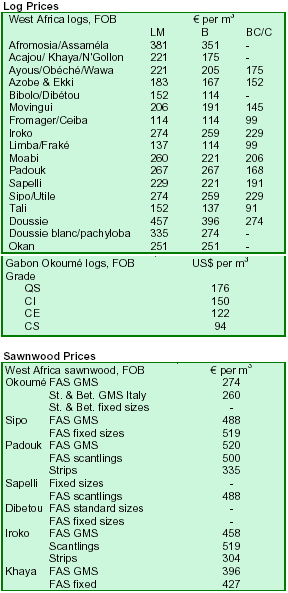
2. GHANA
Ghana to promote wood quality and standardization
An ITTO-funded project to promote quality control and standardization of wood products has begun in Ghana. It
is being implemented by the Forestry Research Institute of Ghana (FORIG), in collaboration with the Timber
Industry Development Division (TIDD) of the Forestry Commission. The project identified as PD 318/04 Rev.2 (I)
aims at developing and promoting the application of quality control guidelines and standards for Ghanaian
timber and wood products in order to ensure sustainable timber and wood product management and efficient
processing, utilization and marketing.
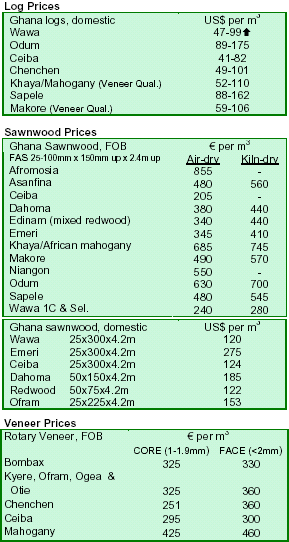
The
above prices are for full sized panels, smaller sizes minus 15%. Thickness
below 1mm would attract a 5% premium.

3.
MALAYSIA
Prices for timber products reach 8-year highs
The Malaysian timber export market is experiencing its biggest boom, after almost a decade of loss and
price-undercutting. Faced with a chronic shortage in raw material supply and with no solution in sight, prices of
Malaysian timber products have risen across the board.
Plywood prices have reached eight-year highs, registering a 10% to 20% increase over 2005. With
strong demand from Japan, China, the Middle-East and India, the situation looks optimistic for at least two more
years. However, both exporters and importers are wary of the price escalation, in light of the appreciation of the
Malaysian ringgit against the US dollar and the rise of crude oil prices in the international market which may
trigger off another round of hike in shipping and freight charges.
Increasingly, importers are looking for alternative sources of supply from Vietnam and Indonesia.
Meanwhile, the local timber industry is urging the various state governments to grant more timber
concessions in order to mitigate the shortage of raw materials. Malaysia aims to increase its forest plantation
areas from 270,000 ha to 600,000 ha in the states of Sabah, Sarawak, Johor, Terengganu and
Pahang.
Positive outlook for plywood industry in 2006
Plywood companies expect positive results this year boosted by the uptrend in plywood prices which have
reached 8-year highs. Companies such as Ta Ann Holdings Bhd said that prices of plywood products had
been improving gradually since the beginning of the year. It reported that some of its transactions in May
registered an increase of more than 20% in various product prices over the 2005 average sale price. It
expressed optimism over the plywood market for the next 1-2 years, given the strong demand from Japan and the
very firm and stable demand from China and India. Tan Ann foresees an improvement of about 10-20% in prices
this year compared with 2005 should the current uptrend continue and given the firm economic fundamentals in
Asia. Considering that log supply is increasingly limited in relation to the processing capacity of wood products,
Tan Ann anticipates higher prices in the long run.
Priceworth Wood Products Bhd reported that the average plywood price achieved by the group had increased to
$380 per m3 in May from $330 in January, partially offsetting higher diesel, spare parts and machinery
maintenance costs as well as the strengthening of the ringgit. Priceworth is also optimistic about the sector¡¯s
prospects for the year. Barring any unforeseen circumstances, Priceworth expects plywood prices to
further improve in the coming months and stabilize over the remainder of the year. Its views were echoed by
Maxtral Industry Bhd.
Eksons Corp Bhd said that although the price of plywood had appreciated well over 20% recently, prices of raw
materials had also risen significantly, especially those of logs, glue, packaging materials and fuel. It expected the
costs of petrol chemical-related products to level off to enable steady income to be maintained in the near term.
However, Eksons' prospects are very optimistic, especially with the opening up of new markets in Asia
such as India, Vietnam and the Middle East.
Despite the general favourable outlook, plywood companies are also preparing for new challenges.
Maxtral expects challenges in the form of inconsistent supply of timber. Although some companies have not
been very much affected by this situation presently, Maxtral reckon that if supply depletes further it will end
hurting the industry. Priceworth, in turn, sees cost control due to the higher costs of machinery maintenance and
diesel to be the group's major challenge.
Malaysia doubles timber exports to Qatar
Malaysia's exports of timber products to Qatar is estimated to have risen by a whopping 96% to $13.1
million in 2005, based on figures recorded in the first three quarters of the year, according to the Malaysian
Timber Council's Dubai-based regional director, Dr. Eric Ng. Exports of wooden and rattan furniture to that
country were estimated at $7.24 million, up 91% from 2004. Other top contributors to the rise in Malaysian
timber exports to Qatar were MDF and plywood. Malaysia exported $2.01 million worth of MDF to Qatar
exported $2.01 million worth of MDF to Qatar from January to September last year, compared with
$1.05 million throughout 2004. Exports of plywood from January to September 2005 were worth $1.03 million,
compared with $500,000 in the whole of 2004. Final figures for 2005 are expected by the end of May.
Last year's exports of timber products from Malaysia to the Gulf Cooperation Council (GCC) countries (Bahrain,
Kuwait, Oman, Qatar, Saudi Arabia and the United Arab Emirates) are estimated at $272.4 million, up 13% from
2004. This constituted 73% of Malaysia's total timber products exported to West Asia, including Jordan, Syria,
Yemen and other smaller markets. The biggest GCC market for Malaysia was the UAE ($134.6 million worth
of exports), followed by Saudi Arabia ($70.9 million) and Kuwait ($34 million).
Massive building projects propel timber demand
The value of construction projects planned or under development in the GCC exceeded $1 trillion as of early
April. In Qatar alone, the value of active projects was estimated at $114.5 billion. Besides facilities recently
completed or under construction for the 15th Asian Games in Doha this December, mega-projects in
development include more than 180 tower buildings, 37 new hotels, the $5.5 billion New Doha International
Airport, the $2.5 billion Pearl Qatar integrated luxury township on a man-made island and two causeways
linking Qatar to Bahrain in the northwest and the UAE in the southeast, which are estimated to cost a total of $5
billion.
EU and Malaysia continue talks on VPA
Negotiations between the EU and Malaysia for a landmark Voluntary Partnership Agreement (VPA) are
still ongoing, informed Thierry Rommel, representative of the European Commission (EC) in Malaysia. The
VPA is part of EU's Forest Law Enforcement, Governance and Trade (FLEGT) initiative aimed at
establishing a trading system and a licensing mechanism to curb the sale of illegal timber products to the EU. Mr.
Rommel further informed that the Netherlands had seconded a FLEGT research expert to help the EC office
in Malaysia with the effort.
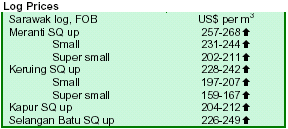

Peninsular Malaysian meranti logs are top grade and are used
for scantlings for the EU. Their prices are higher than Sarawak¡¯s.
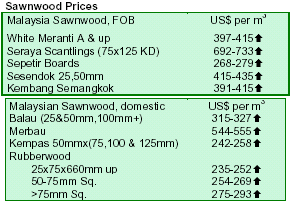
4.
INDONESIA
3 trillion rupiah fund for infrastructural development
The Indonesian timber industry received a boost in confidence with the announcement that the government
will set aside a 3 trillion rupiah ($343.5 million) yearly rotating fund for infrastructural development. The fund is
an incentive for foreign investors to participate in projects in Indonesia. This is expected to provide timely
support for the ailing local building material industry.
Indonesia cuts processing time to 30 minutes
The Indonesian government will be implementing a scheme to reduce the processing of import and export
permits from 30 days to just 30 minutes. A World Bank report stated that an export permit takes 30 days, while
an import permit takes up to 10 days to be processed in Indonesia. This has hamstrung the Indonesian business
community.
Timber prices climb in tandem with region¡¯s trends
Timber prices in Indonesia continue to rise moderately in tandem with the rest of the region. However, rubberwood
prices have breached a new high. Some traders indicated that the strong prices are due to Malaysian and mainland
Chinese players sourcing for rubberwood supplies.
Log shortage leads to closure of scantling plants
German importers have recently reported that most of Indonesian window scantlings plants have ceased
production due to the acute ongoing log shortage, according to Euwid. German importers have described
the supply of meranti scantlings and bankirai and meranti lumber as dramatic in the second quarter of 2006. The
relaxation of the sawnwood export ban in March 2006 (see TTM 11:4) has not alleviated the tight supply
situation. Since the volumes of meranti scantlings from
Malaysia are limited, analysts anticipate supply bottlenecks in the next few weeks as German traders run
out inventories.
Some German importers have been trying to source substitutes such as keruing, kapur and plantation durian
from Southeast Asia, massaranduba from Brazil and plantation eucalyptus from Spain. However, this measure
is considered as a temporary solution as these substitutes
do not posses the same properties or are not available in sufficient volumes on a regular basis.
Shippers threaten to stop transport of logs
The Indonesian National Ship-owners Association (INSA) has threatened to stop transporting logs if the
government insists on enforcing a new decree on the transportation of illegal timber. INSA said the
government¡¯s call for ships carrying illegal timber to be impounded would cause massive losses to the local
shipping industry. INSA contends that the authorities should only confiscate illegal
wood, not the ships.
The decree was intended to replace a 2003 decree that required ships carrying illegal timber to unload the logs
at the next port before being allowed to continue the voyage. Indonesia's Sea Transportation Director,
Hartsjarja Harijogi said the decree was in line with the 1999 Forestry Law, which states that all parties involved
in the transportation of illegal timber must be detained for investigation.
Indonesia plans first bio-diesel plant by 2008
PT Bakrie Sumatera Plantations Tbk (BSP), in association with PT Rekayasa Industri (Rekin), plans to
build Indonesia's first bio-diesel plant with a capacity of 60,000 to 100,000 tonnes a year at a cost of $25 million.
The joint venture called PT Bakrie Rekin Bio-Energy expects to complete the plant in 2008. BSP, which
manages 31,000 hectares of oil palm plantations in Jambi, will provide the raw materials needed to produce
bio-diesel, including crude palm oil (CPO) and other feedstock, while Rekin would provide engineering and
construction expertise.
Indonesian demand for diesel amounts to 460,000 barrels per day, or 27 million kiloliters per year, of which 30% is
imported. Analysts said that biodiesel could serve as an alternative for unsubsidized diesel used by industry or
exported. It is predicted that Indonesia will produce 14.7 million tonnes of palm oil in 2006, up from 13.6 million
tonnes in 2005. Currently the biofuel mix is around 5% palm oil and 95% diesel, but some analysts believe the proportion of palm oil could increase to 20%.
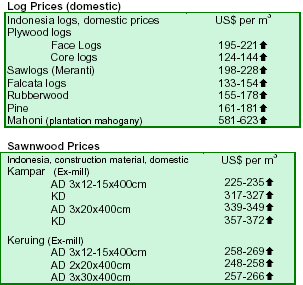
5.
MYANMAR
German buyers active in teak sales
The teak log market is still quite active with German buyers coming in strongly during the March and April
tenders. German buyers mostly prefer 4th Quality, SG-1 and SG-2 grades and buy SG-4 only if the quality is
exceptionally good. Lower grades like SG-5 (assorted), SG-6 (domestic) or lower also fetch good prices, but
some buyers complain that prices for these grades are already quite high.
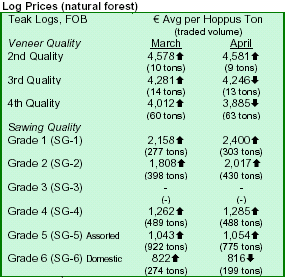
Hoppus ton=1.8m3; All
grades, except SG-3, assorted and domestic, are length 8¡¯ x girth
5' and up. SG-3 is girth 4' and up while assorted and domestic are girth 4'
and up. SG-3 grade is higher than SG-4 but with lower girth and price.
In contrast, the local market for teak processing remains weak as in the second half 2005 and first quarter 2006.
Local timber businessmen continue to struggle in securing industrial raw logs for their fledgling industries.
The market for other hardwood logs is sluggish. Prices for pyinkadoe logs have been stable but higher prices are
seen when traders resell logs bought from MTE with margin. The market for gurjan (keruing) continues to
depend on keruing production in Malaysia and Indonesia.

Prices
differ due to quality or girth at the time of the transaction.
6. PAPUA
NEW GUINEA
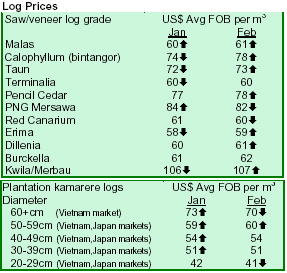
7.
BRAZIL
Para's Simaspa urges approval of new PMFS
The solid wood sector in western Para, in the Brazilian Amazon, has laid-off over 13,000 employees since late
2004, according to the Wood Industry Union of Southwestern Par¡§¢ (Simaspa). Simaspa says that this has
created a social crisis, which resulted from the suspension and cancellation of the so-called Sustainable
Forest Management Plans (PMFS) by the federal government, which guaranteed the supply of legal
sawlogs to local sawmills. Simaspa has urged the federal government to intervene in the crisis and to comply with
the Conduct Adjustment Terms (TAC) signed in 2005, which foresaw the approval of forest management areas
up to the end of 2006.
According to Simaspa, there are 253 forest companies employing 17,500 workers operating in the area along
the Santarem (Para)-Cuiaba (Mato Grosso) federal road. Out of this total, 13,125 employees (75%) have already
been dismissed and 2,625 more (15%) are about to be laid-off. More lay-offs are contemplated should the
suspension of PMFS persist. The Ministry of the Environment has proposed the approval of 10 new PMFS
but the sector finds it insufficient since the TAC planned 250 PMFS. The sawnwood sector is the second major
economic activity in Para, with exports of $543 million (56% of which are added-value products).
Para has 33
sawnwood clusters and 1,592 forest companies with annual revenue of $1.1 billion and a total of 60,107 direct
and 123,634 indirect employees.
Wood shortage limits growth of furniture industry
The growing consumption of planted roundwood by the wood pulp and steel sectors (for charcoal) is reducing the
supply of wood panels to the furniture sector. Estimates suggest that if furniture sales in 2006 expand over 15%,
this will put pressure on wood supply beyond sustainable production levels, leaving the furniture sector facing
serious supply problems. The Brazilian Association of Furniture Industries (ABIMOVEL) expects that the sector
will grow 10-15% in 2006. Rather than improving companies¡¯ profitability, this growth may bring about
higher expenses as a result of price readjustments of roundwood, wood panels and furniture products.
Furniture exports retreat in the first quarter of 2006
Brazil exported 9% less furniture in the first quarter of 2006 in comparison with the same period last year. The
USA, Brazil's main furniture importer, decreased imports to $71.9 million in the first quarter of 2006, down 20%
from the same period in 2005. This is a direct consequence of the difficulty in passing on increasing
costs and the emergence of Chinese furniture in the US market, which have taken market share away from
Brazilian furniture. Exports of Brazilian furniture also declined in respect of France (down 23% to $17.3
million), Germany (down 56% to $6.3 million) and the Netherlands (down 38% to $5.8 million) during the first
quarter of the year. However, increased exports were registered in the UK (up 11%), Spain (up 19%),
Argentina (up 49%) and Mexico (up 49%). Although furniture exports to Chile, Argentina, Uruguay and
Mexico are comparatively smaller, these are growing at a fast pace.
Exports from the furniture cluster of Santa Catarina, southern Brazil which is also the main furniture exporter,
dropped 20% to $84.7 million in the first quarter of 2006. The sector is losing
competitiveness mainly due to high production costs. Although the domestic market may be
an alternative, switching production to supply the lines consumed domestically demands high investment that
most producers are not capable of making. Analysts say that an alternative to raising exports, particularly to the
key US market, is enhancing timber product value.
Facing economic constraints by value-adding
The continuing devaluation of the US dollar against the Brazilian real in 2005 and part of 2006 is making it
difficult for the solid-wood sector in Brazil, particularly those focused on exports. However, some experts have
positive expectations for 2006 and 2007. Brazil is the world's seventh largest exporter of solid wood products
and shares the leadership in South America with Chile. Brazil now exports 15% of its wood production and has
room to increase its global market share. High cost
logistics are one of the basic constraints to export expansion, with a host of problems with
transportation, container leasing and port strikes.
Brazil's main exports wood products are made from pines, produced mostly in the South and Southeast
region. These account for almost 80% of the total forest products exports. On the other hand, exports of tropical
timber, produced mainly in the North and West-Central regions, have grown at a lower rate in recent years. Some
wood exporter and producer associations have indicated that one of the alternatives to increasing wood exports
under current economic constraints is to add greater value to products. Although Brazil exports mainly
sawnwood and processed timber, exports of finished wood products have grown rapidly. Analysts stress that
value-added products increase profitability, allow the use of new technologies, improve
staff's technical skills and
expand the matrix of products and industrial operations.
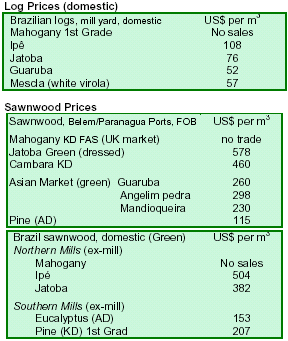
8. PERU
Delayed certificates push mahogany exports down
Exports of mahogany (Swietenia macrophylla) dropped 21% to 3,608.4 m3 in the period January-February 2006
Exporters indicated that the decline was due to delays in the issuance of CITES certificates by INRENA for this species as well as Spanish cedar (Cedrela odorata). The main markets for mahogany products in the period were the USA (81% of the exports) and Dominican Republic (14%). Exporters also complained about the lack of information on CITES certificates being issued on
INRENA's website.
Sunat on board in fight against illegal logging
In support of its efforts to improve timber trade controls nationwide, INRENA is receiving assistance from the
National Superintendence of Tax Administration (Sunat) in the supervision of timber companies. The timber
industry has agreed to cooperate with Sunat inspections and requests for documentation. However, some
companies complain that the inspections are delaying their operations. They argue that Sunat is also requesting
information on species not listed in CITES such as cumaru and massaranduba. The companies have suggested
INRENA to organize training workshops on illegal logging control for Sunat's inspectors similar to those carried out
for the press and the army.
Strong friezes exports attract new investment
The demand for friezes or pre-finished flooring manufactured from species such as cumaru,
massaranduba and cabreuva (estoraque) continues to grow in 2006. Exports of these products, corresponding
to HS code 4409201000 ¡¡ãhardwood siding for flooring¡¡À, amounted to $7.42 million in the first quarter of 2006, up
84% from the same period in 2005. The export increase has motivated some timber companies to expand capacity
and purchase machinery (projected at $7 million in 2006) to manufacture solid wood pre-finished floorings for the
export markets of Europe and the USA.
Amazon office seizes illegal wood
As part of INRENA overall efforts to curb illegal logging, the Forest and Wildlife Technical Administration of the
Amazon region (ATFFS-Amazonas) seized illegal wood in the first quarter of 2006, surpassing the volumes seized
in previous years. ATFFS-Amazonas confiscated 28,764 BF of different wood species, including 8,412 BF of
Spanish cedar and 5,707 BF of cabreuva (estoraque) seized in a single operation.
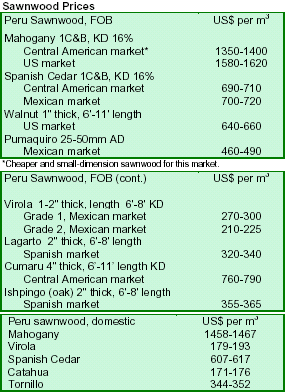
9. BOLIVIA
Concerns on recent statements by Mr. Morales
Speaking at an oilfield in southern Bolivia early May, President Evo Morales said that
"the pillage" of the country's natural resources by foreign companies was over. Mr. Morales said the gas fields were just the
beginning, because tomorrow it would be the mines, the forest resources and the land. Mr. Morales reiterated his
statement later at the Fourth EU-Latin America/Caribbean Summit in Vienna on 12 May,
adding that there was huge private land ownership, especially unproductive land, in the country. Forest
concessionaires in Bolivia have expressed concern on these statements and have urged the government to
immediately clarify its position regarding forest
concessions, which include all 2.2 million ha of the existing FSC forest in Bolivia.
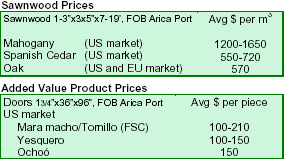
10. Guatemala

11.
Guyana
Exports gain momentum after slow start
After a slow start at the beginning of the year due to heavy rainfalls, there was a significant increase in the
export of forest products from Guyana in March. In the first quarter of 2006, total export earnings were just over
$11 million, with sawn lumber and logs accounting for the bulk of exports.
Purpleheart logs enjoy steep surge in prices
While log prices for most species remain relatively stable, purpleheart prices continue to climb steeply with
prices per m3 for larger sizes logs reaching $190, up from $160. This is also strengthening purpleheart sawn lumber prices.
Guyana's sawn lumbers gain market acceptance
While the growing Caribbean market continues to be the main destination for Guyanese sawn lumber, there are
increasing enquires and orders from the USA and Europe. Greenheart is now gradually being accepted as a
decking substitute for Brazilian ipe while mora is gaining popularity in the flooring market as a substitute for
Brazilian jatoba. Other lesser used species are also gaining popularity, including wallaba
(Eperua spp.) which is gradually gaining acceptance in sawn lumber form in Asia. There is also a resurgence of wallaba
shingles for roofing and poles for transmission lines in the Caribbean.
Guyana enhances grading and quality control
The increased demand in the Caribbean, USA and Europe for Guyana's wood products is partially due to
enhanced grading and quality control in Guyana, according to the Forest Products Marketing Council of
Guyana, Inc. (FPMC). As of mid-April 2006, the Guyana Forestry Commission and the FPMC had trained
46 personnel as qualified timber graders in an effort to support the drive to improve quality control of wood
products leaving Guyana. These institutions plan to shift this effort to the domestic market as well to support the
value-adding sector.
Guyana audits is timber tracking system
The Guyana Forestry Commission has engaged UK's PROFOREST to conduct a comprehensive audit of the
country's log tracking system used for tracking forest products. This activity is funded by ITTO as part of the
Council's Decision which requires the Organization, upon request, to assist countries to develop systems to demonstrate the legality of timber exports.
PROFOREST will develop a Legal Verification System (LVS) compatible with other internationally recognized
schemes such as the EU Forest Law, Enforcement, Governance and Trade (FLEGT) initiative and the
WWF's Global Forest and Trade Network (GFTN). The LVS will comprise five main elements: i) definition of
legality, ii) adequate traceability (chain of custody), iii) verification of legality, iv) licensing and v) independent
monitoring. The LVS development process will involve the review of current systems, stakeholder consultation,
technical workshops, field testing and training of auditors.
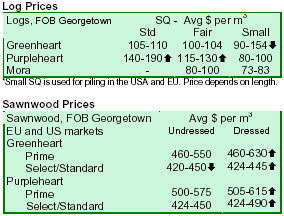
|